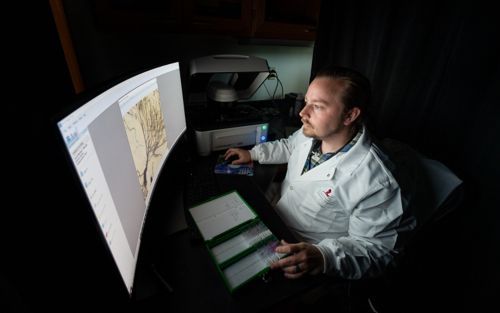St. Jude Family of Websites
Explore our cutting edge research, world-class patient care, career opportunities and more.
St. Jude Children's Research Hospital Home

- Fundraising
St. Jude Family of Websites
Explore our cutting edge research, world-class patient care, career opportunities and more.
St. Jude Children's Research Hospital Home

- Fundraising
Lysosomal drugs licensed for neurodegenerative disease may also hold promise for cancer
We licensed the patent rights for using PPCA and Neurominidase to treat neurodegenerative diseases in 2015, but additional fields remain available and increasingly promising.
Dr. Alessandra d’Azzo’s research programs at St. Jude Children’s Research Hospital explore the role of the lysosomal system in cellular metabolism and in diseases associated with lysosomal dysfunction, collectively known as lysosomal storage diseases (LSDs). LSDs are catastrophic, neurodegenerative childhood disorders with complex pathological manifestations, affecting all organs, including the nervous system. Understanding the molecular bases underlying LSD pathogenesis is key for the development and implementation of effective therapies for these diseases and other related adult conditions.

The d'Azzo Lab: Alessandra d'Azzo, PhD (center), (clockwise, starting lower left) Diantha van de Viekkert, Leigh Fremuth, PhD, Elida Gomero, Yvan Campos, Jason A. Weesner, PhD, Huimin Hu, PhD.
The lysosome is the primary digestive system within cells, ensuring the homeostatic balance between synthesis and breakdown of macromolecules. When lysosomes cannot properly exert their degradative function, undigested or unprocessed materials accumulate within cells or are abnormally released extracellularly, which ultimately affect cell survival and the integrity of the extracellular environment. A dysfunctional lysosomal system has been implicated in pathogenic cascades leading to neurodegeneration and cancer metastasis. Dr. d’Azzo’s lab has thoroughly dissected some of the mechanisms and pathways downstream of specific lysosomal defects, broadening the understanding of the role of these vital organelles in pediatric and adult diseases.
The work of the d’Azzo lab centers on the study of three lysosomal enzymes, each of which is essential for proper lysosomal degradation of multiple cellular constituents:
- Protective Protein/Cathepsin A (PPCA)
- b-Galactosidase (b-GAL)
- Neuraminidase 1 (NEU1)
These enzymes form a high molecular weight lysosomal multienzyme complex (LMC), a configuration required for their mutual stability in lysosomes and acquisition of full enzymatic activity. Three genetically distinct, human neurodegenerative LSDs result from single or combined deficiency of these enzymes:
- Galactosialidosis (primary defect in PPCA, secondary deficiency of NEU1 and b-GAL)
- GM1-gangliosidosis (primary defect in b-GAL)
- Sialidosis (primary defect in NEU1)

The lysosome is the primary digestive system within cells, ensuring the homeostatic balance between synthesis and breakdown of macromolecules. When lysosomes cannot properly exert their degradative function, undigested or unprocessed materials accumulate within cells or are abnormally released extracellularly, which ultimately affect cell survival and the integrity of the extracellular environment. A dysfunctional lysosomal system has been implicated in pathogenic cascades leading to neurodegeneration and cancer metastasis. Dr. d’Azzo’s lab has thoroughly dissected some of the mechanisms and pathways downstream of specific lysosomal defects, broadening the understanding of the role of these vital organelles in pediatric and adult diseases.
The work of the d’Azzo lab centers on the study of three lysosomal enzymes, each of which is essential for proper lysosomal degradation of multiple cellular constituents:
- Protective Protein/Cathepsin A (PPCA)
- b-Galactosidase (b-GAL)
- Neuraminidase 1 (NEU1)
These enzymes form a high molecular weight lysosomal multienzyme complex (LMC), a configuration required for their mutual stability in lysosomes and acquisition of full enzymatic activity. Three genetically distinct, human neurodegenerative LSDs result from single or combined deficiency of these enzymes:
- Galactosialidosis (primary defect in PPCA, secondary deficiency of NEU1 and b-GAL)
- GM1-gangliosidosis (primary defect in b-GAL)
- Sialidosis (primary defect in NEU1)
Investigating the biological mechanisms downstream of genetic defects in PPCA, b-GAL, and NEU1 has enabled Dr. d’Azzo’s group to identify paralleled pathogenic cascades that also occur in common adult diseases, while simultaneously developing new drugs and therapies for LSD patients that could in principle be applied to other debilitating or difficult-to-treat disorders.
One prominent example of their research is the study on the pathogenesis of sialidosis that unveiled a previously unknown function of NEU1 as negative regulator of the basic biological process called lysosomal exocytosis. When NEU1 levels are low one of its substrates, LAMP1, accumulates in a hypersialylated state within lysosomal membranes. This drives an excessive number of lysosomes to dock at the plasma membrane (PM), ready to fuse with the PM and release their contents extracellularly. The end result is exacerbated lysosomal exocytosis, leading to excessive amounts of lysosomal constituents, including active proteases, within the extracellular space. This pathogenic phenomenon occurs in various cell types with dire consequences for the integrity and homeostasis of all tissues and organs. Using these important findings as a paradigm, Dr. d’Azzo’s group successfully linked NEU1 deficiency and excessive lysosomal exocytosis to several pathological manifestations characteristic not only of sialidosis, but also common adult diseases. For example, they established that in brains with NEU1 deficiency/downregulation, excessive lysosomal exocytosis contributes to the abnormal extracellular release of toxic amyloid, the propagation of a massive neuroinflammatory response and the development of an Alzheimer’s disease phenotype. Moreover, they linked differential downregulation of NEU1 and increased exocytosis of lysosomal contents to the transition of primary tumors to an aggressive and drug-resistant state. Therefore, dysregulated pathways downstream of NEU1 deficiency/downregulation can explain aspects of disease pathogenesis in pediatric lysosomal diseases, as well as more common adult conditions, like Alzheimer’s disease and cancer.
By selectively downregulating NEU1, tumor cells, and other cells of the tumor microenvironment, successfully hijack lysosomal exocytosis and use the process advantageously to release chemotherapeutics accumulated in lysosomes, obtaining a drug resistant state, and to remodel the extracellular space, promoting evasion and metastasis.

In 2013, Dr. d’Azzo and members of her group, filed an invention patent outlining how lysosomal exocytosis activity profiles could be used for the prognosis and diagnosis of the various pathological states of cancer, chemotherapy resistance and dementia associated with Alzheimer’s disease. Additionally, the patented invention included methods using NEU1 and NEU1 auxiliary protein (PPCA) to treat cancer and Alzheimer’s disease. While the neurodegenerative fields were subsequently licensed for further development by industry, we are now seeking partners to develop cancer treatments and diagnostics.
Our approach is two-fold: we want to license this patent to companies who will develop diagnostic tests to predict chemotherapy resistance, cancer aggressiveness, and disease prognosis. In addition, we want to license the patent to companies who seek to improve current cancer treatments by developing new therapeutics that target NEU1, LAMP1, PPCA and/or lysosomal exocytosis, and will help prevent metastasis or improve targeted cytotoxicity of chemotherapies. Addressable cancers include different types of sarcomas (rhabdomyosarcoma, Ewing's sarcoma), leukemias (acute lymphoblastic leukemia), lymphoma, melanoma, breast cancer, colon cancer, lung cancer, bladder cancer, pancreatic cancer, ovarian cancer, prostate cancer, brain tumors, and bone cancer.
A variety of approaches—ex vivo gene therapy, AAV-mediated in vivo gene therapy, enzyme replacement therapy, small molecule/drug therapy— can be used to restore or enhance enzyme function and aid the development of effective therapies for pediatric and adult diseases affecting the lysosomal system. These ventures could lead to new therapeutic classes, with multiple generations and numerous treatments.
The intellectual property and seven publications relating to the cancer aspects are listed below.
- Issued US 9,399,791; 9,840,727; 10,533,208; and published pending 2020/0087704. Issued/Allowed patents in Europe, Canada, Australia, and Japan as well.
- Haploinsufficiency of the lysosomal sialidase NEU1 results in a model of pleomorphic rhabdomyosarcoma in mice
https://pubmed.ncbi.nlm.nih.gov/36127469/ - Lysosomes and Cancer Progression: A Malignant Liaison
https://pubmed.ncbi.nlm.nih.gov/33718382/ - Regulated lysosomal exocytosis mediates cancer progression
https://pubmed.ncbi.nlm.nih.gov/26824057/ - Excessive exosome release is the pathogenic pathway linking a lysosomal deficiency to generalized fibrosis
https://pubmed.ncbi.nlm.nih.gov/31328155/ - MYC competes with MiT/TFE in regulating lysosomal biogenesis and autophagy through an epigenetic rheostat
https://pubmed.ncbi.nlm.nih.gov/31399583/ - Preclinical Enzyme Replacement Therapy with a Recombinant β-Galactosidase-Lectin Fusion for CNS Delivery and Treatment of GM1-Gangliosidosis
https://pubmed.ncbi.nlm.nih.gov/36010656/ - AAV-mediated gene therapy for galactosialidosis: A long-term safety and efficacy study
https://pubmed.ncbi.nlm.nih.gov/34901309/
Key developmental assets include: generation and characterization of knockout and transgenic mice (A Neu1 KO mouse was generated and characterized in early 2000); correction of affected mice by transplantation with transgenic overexpressing or retrovirally transduced bone marrow; expression and regulation of normal and mutant enzymes in prokaryotic/eukaryotic cell systems; and crystal structure determination of overexpressed proteins.